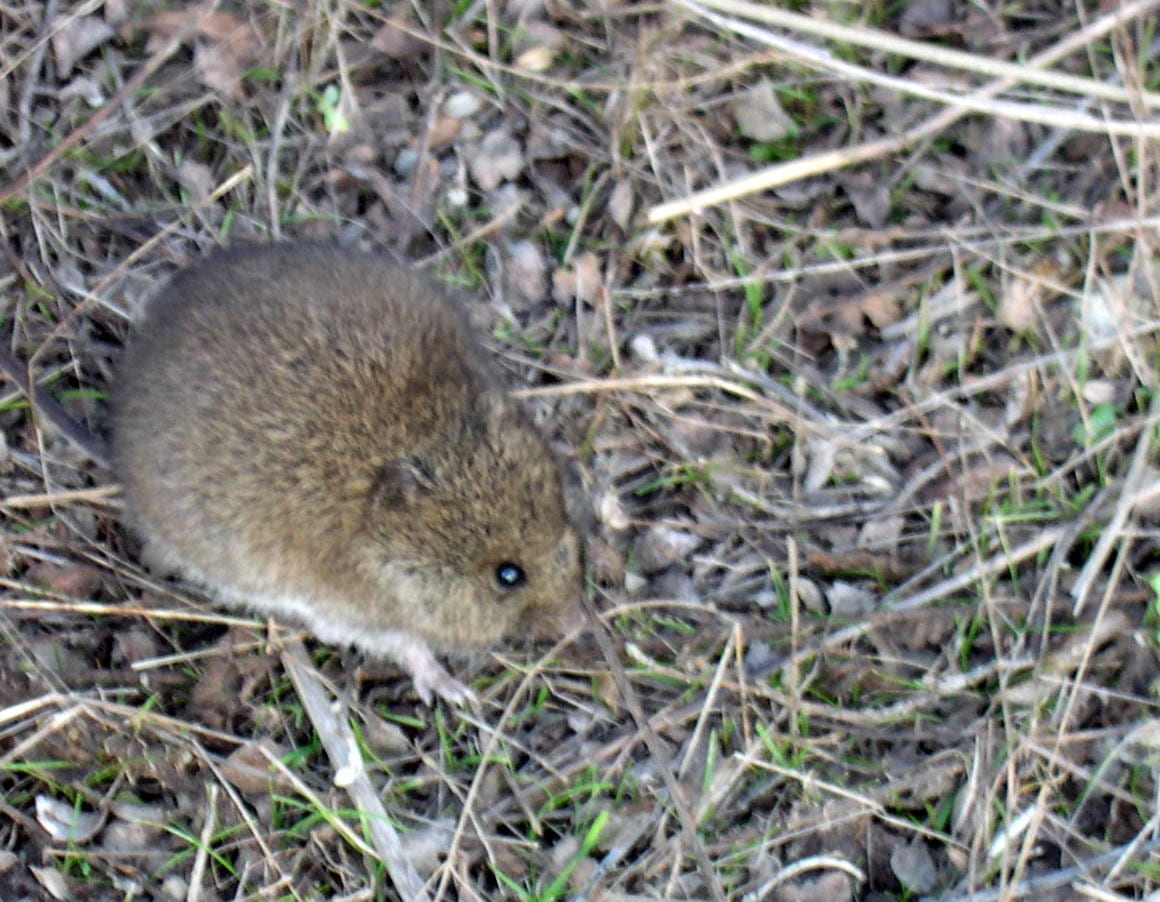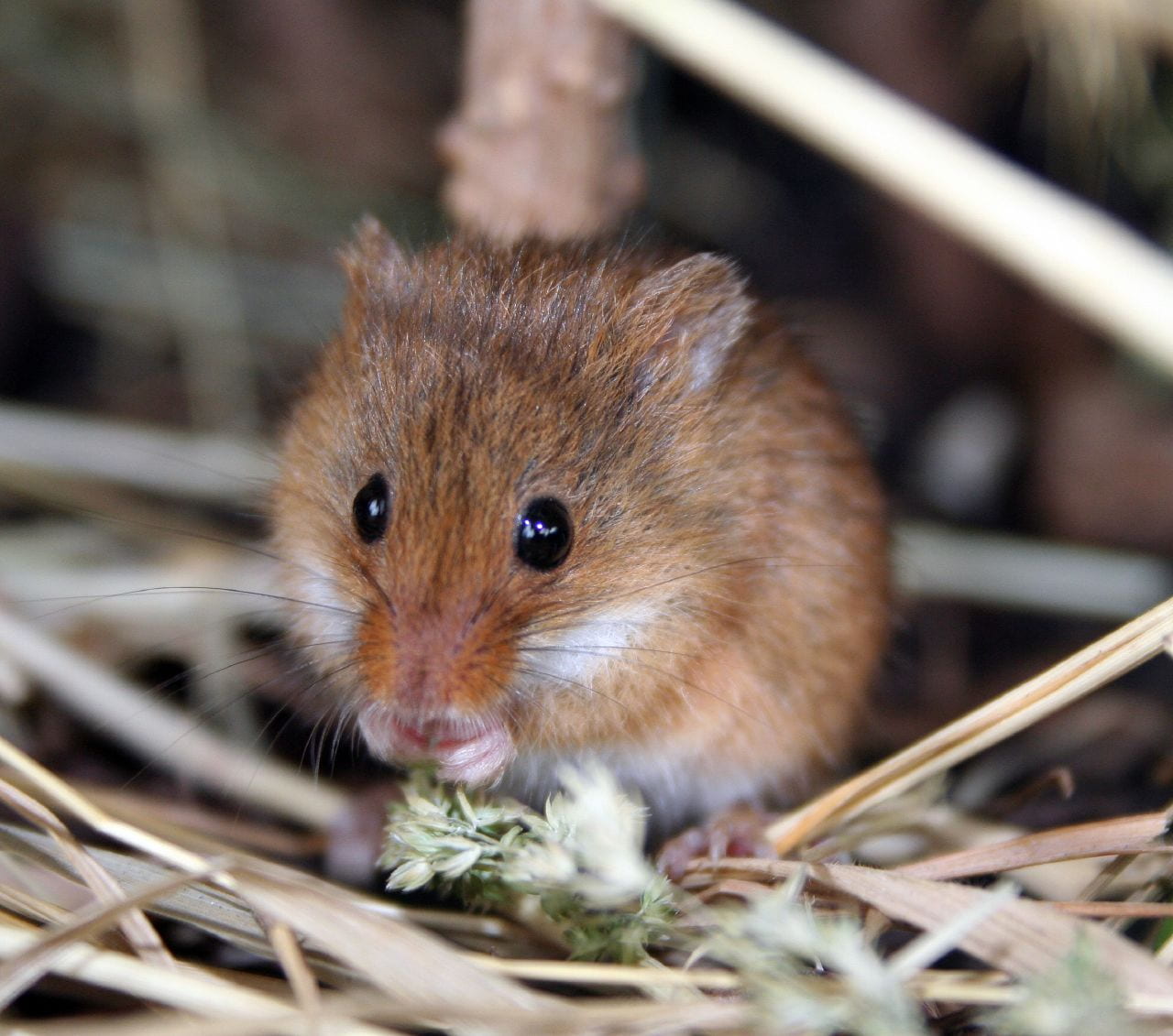Suborder: Myomorpha (mice, rats, gerbils, jerboas, and relatives):
Superfamily Dipodoidea:
Family Dipodidae (birch mice, jerboas, and jumping mice):
- Genus: Zapus
- Meadow jumping mouse – Z. hudsonius
Superfamily Muroidea:
Nearly every species of myomorpha within Missouri fall under the superfamily Muroidea. Members can be found on every continent except Antarctica, and they live in a wide and diverse range of ecosystems. Being such a diverse group, it is difficult to make generalizations about the characteristics, attributes, and behaviors of its members. They are typically polygynandrous, meaning males and females each have multiple mates over the course of a breeding period (animaldiversity.org). These rodents commonly have a high reproductive output at an early age and a high mortality rate. Many species have the ability to become pregnant again immediately after giving birth, and most muroids do not live more than two years in the wild (animaldiversity.org).
Family Cricetidae (New World rats and mice, voles, hamsters, and relatives):
- Genus: Peromyscus
- Cotton mouse – P. gossypinus
-
- North American deermouse – P. maniculatus

(Picture courtesy of the CDC and the Partnership, Inc.) [CC BY 2.5 (https://creativecommons.org/licenses/by/2.5)], via Wikimedia Commons
-
- Texas mouse – P. attwateri
- White-footed mouse – P. ieucopus

Charles Homler [CC BY-SA 3.0 (https://creativecommons.org/licenses/by-sa/3.0)], from Wikimedia Commons
- Genus: Reithrodontomys
- Plains harvest mouse – R. motanus
-
- Western harvest mouse – R. megalotis

C. Michael Hogan [Public domain], from Wikimedia Commons
-
- Fulvous harvest mouse – R. fulvescens

Photo 253393, (c) greglasley, some rights reserved (CC BY-NC), uploaded by Greg Lasley to inaturalist.org
- Genus: Microtus
- Meadow vole – M. pennsylvanicus
-
- Prairie vole – M. ochrogaster
-
- Woodland vole – M. pinetorum
- Genus: Neotoma
- Eastern woodrat – N. floridana
- Genus: Ochrotomys
- Golden mouse – O. nuttalli
- Genus: Ondatra
- Muskrat – O. zibethicus

D. Gordon E. Robertson [CC BY-SA 3.0 (https://creativecommons.org/licenses/by-sa/3.0) or GFDL (http://www.gnu.org/copyleft/fdl.html)], from Wikimedia Commons
Being semiawuatic, the musrkat has dense fur with long and glossy guard hairs, along with partially webbed hind feet. Their laterally compressed and scaly tail may be used to slap water when the muskrat is alarmed. Muskrats swim well and are typically seen in or close to water (Reid 326). Muskrats can stay underwater for up to 15 minutes, and they use their tail and webbed feet to propel themselves while swimming (nhpbs.org). More buoyant than beavers, muskrats can be seen as two or three separate humps in the water while swimming, while beavers swim with only their head exposed as one hump (Reid 326).
The diet of the muskrat is largely cattails and other aquatic vegetation such as sedges, rushes, and water lilies. Muskrats have been known to also eat small animals such as snails, mussels, clams, crayfish, frogs, and fish (nhpbs.org). They can close their lips behind their incisors as to harvest food underwater without taking in water, (Reid 326). Typically muskrats drag their found food to constructed feeding stations or platforms before eating (nhpbs.org).
- Genus: Oryzomys
- Marsh rice rat – O. palustris
- Genus: Sigmodon
- Hispid cotton rat – S. hispidus
- Genus: Synaptomys
- Southern bog lemming – S. cooperi

PaulT [GFDL (http://www.gnu.org/copyleft/fdl.html) or CC BY-SA 3.0 (https://creativecommons.org/licenses/by-sa/3.0)], from Wikimedia Commons
Despite its name, the Southern Bog Lemming is actually just a type of small vole (biokids.umich.edu). Most voles, however, typically have longer tails than these lemmings, which have almost no tails. They are digging animals, typically nesting in underground burrows. May travel along constructed surface runways or below the surface in mole tunnels (Reid 328).
Their runways are 2.5 to 5 cm in diameter and can be found in heavy foliage. The runways are maintained by trimming back any new vegetation. The lemming’s runways are distinct from those of other voles because of the piles of grass they leave next to their runways (biokids.umich.edu).
In light of its name, the Southern Bog Lemming may primarily be found in sphagnum bogs. Other places they can be found include dense woodlands, dry bluegrass fields, and spruce-fir forests. In particular they’ll be in or near green grass and sedge (Reid 328). Their diet consists mostly of herbaceous plants, leaves, stems, and seeds, with bluegrass being a staple. May also eat roots, mosses, fungi, fruits, bark, sedges, as ell as slugs, snails, and beetles. Due to the sheer amount of green vegetaion they consume, their droppings are a uniformly light green color (biokids.umich.edu).
Family Muridae (Old World rats and mice, gerbils, whistling rats, and relatives):
- Genus: Mus
- House mouse – M. musculus

Rasbak [GFDL (http://www.gnu.org/copyleft/fdl.html) or CC-BY-SA-3.0 (http://creativecommons.org/licenses/by-sa/3.0/)]
- Genus: Rattus
-
- Brown rat – R. norvegicus

AnemoneProjectors [CC BY-SA 2.0 (https://creativecommons.org/licenses/by-sa/2.0)], via Wikimedia Commons
This is the rat known to many urbanites. It’s the one seen raiding bird feeders or crawling through subway systems (Reid 333). Lives on every continent except Antarctica. Can be found anywhere from urban environments, residing in sewers or buildings, to forests or open fields (nationalzoo.si.edu). Will eat just about any available food, including grains, fruits, garbage, and even young livestock. Causes extensive damage to stored grains (Reid 333). Also may eat food directly from cupboards or crops from fields (nationalzoo.si.edu). North America’s most sseriosu pest mammal, in addition to invading homes and disrupting agriculture, the Norway rat may cause damage to structures and is a vector for disease (Reid 333).
Although it is known as the Norway rat, the species is actually native to China and Southeast Siberia (Reid 333). Originally lived primarily in forests, but now lives nearly anywhere humans reside. They make their homes in complex burrow systems with many chambers for storing food and nesting. Norway rats live in large groups, dominated by males and hierarchy is determined by size. Mating is year round, and the rats are polygnandrous. Lifespan is approximately two years (naitonalzoo.si.edu).
Citations:
Blanchard, Robert J., Kevin J. Flannelly, and D. Caroline Blanchard. “Defensive behaviors of laboratory and wild Rattus norvegicus..” Journal of Comparative Psychology 100.2 (1986): 101.
“Common Muskrat – Ondatra zibethicus – NatureWorks.” New Hampshire PBS, nhpbs.org/natureworks/muskrat.htm
Fahey, Bridget. “Southern Bog Lemming.” Edited by Tanya Dewey et al., BioKIDS – Kids’ Inquiry of Diverse Species, www.biokids.umich.edu/critters/Synaptomys_cooperi/.
Myers, Phil, and Allison Poor. “Muroidea (Mice, Rats, Gerbils, and Relatives).” Edited by Tanya Dewey, ADW: Rhinoceros: CLASSIFICATION, animaldiversity.org/accounts/Muroidea/.
“Norway Rat.” Smithsonian’s National Zoo, 11 July 2018, nationalzoo.si.edu/animals/norway-rat.
“Photo 253393, (c) Greglasley, Some Rights Reserved (CC BY-NC), Uploaded by Greg Lasley · INaturalist.org.” INaturalist.org, www.inaturalist.org/photos/253393.
“Rodents: Rodentia.” A Field Guide to Mammals of North America, by Fiona A. Reid, 4th ed., Houghton Mifflin Company, 2006, pp. 177–340.
Siegal, Ann Cameron. “Beaver or Muskrat? Here’s How to Tell.” The Washington Post, WP Company, 21 May 2012, www.washingtonpost.com/lifestyle/kidspost/beaver-or-muskrat-heres-how-to-tell/2012/05/21/gIQA6ceOgU_story.html?noredirect=on&utm_term=.9a1638f66823.
Is that a muskrat or a beaver?
Beavers and muskrats are not always easy to tell apart. The animal’s tails are the difinitive way to make an accurate identification. Beaver tails are flat and paddle shaped, whereas muskrats have longer tails with flat sides. Another way to get a better idea of what you’re looking at is by considering the animal’s size. Beavers are big. Typically weighing between 35 and 60 pounds, they easily outsize muskrats which are closer to four pounds. The animal’s lodges have some slight differences as well. Beavers tend to use more mud in their constructions than muskrats. What may cause confusion, however, is that muskrats will occasionally move into beaver lodges. This arrangement may be beneficial to the architects of the lodge as muskrats can help alert beavers to the presence of predators (washingtonpost.com).
Southern or Northern?
The Southern Bog Lemming looks very much like its close relative the Northern Bog Lemming, however the two can be distinguished via their incisors. Southern Bog Lemmings have ungrooved incisors, whereas those of their counterpart are grooved (Reid 328). Additionally, female Southern Bog Lemmings have 6 mammae while their counterparts have 8 (biokids.umich.edu). Only Southern Bog Lemmings are present in Missouri (Reid 328).
Lab rats
Despite the many negative impacts Norway rats have on human society, they aren’t all bad. Norway rats have been bred for laboratory use and have helped researchers make advancements in science and medicine (Reid 333). Interestingly, lab rats tend to be less defensive than wild rats when confronted with threatining stimuli; a behavior that must have been altered through the course of domestication (Blanchard et al. 101).









